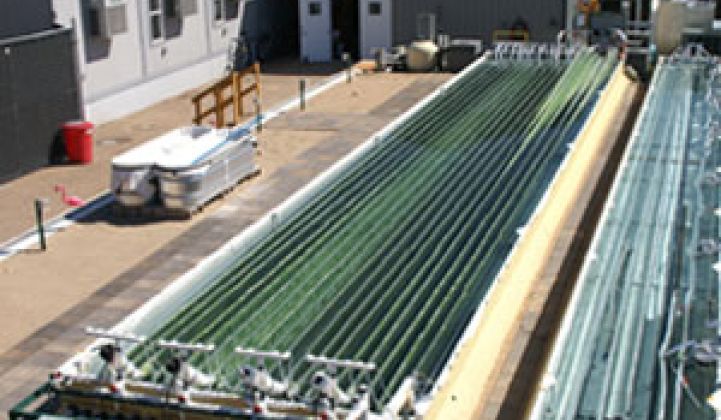What's the key to algae fuel? The bubbler, according to Solix CEO Doug Henston.
Algae in bioreactors – clear, water-filled chambers that let the microorganisms absorb sunlight – need carbon dioxide to feed and grow. Typically, the carbon dioxide is pumped in from a smokestack at a nearby power plant. Injecting that CO2 and circulating it around the tank, however, requires quite a bit of energy, which in turn adds cost.
The Durango, Colo.-based company, which can trace its lineage, in part, back to the algae projects at the National Resources Energy Lab in the 1970s, ‘80s and ‘90s, says it has come up with a way to lets CO2 essentially enter and swirl inside the tank in a relatively passive manner.
As a result, Solix claims that it has cut the costs of growing algae by around 90 percent to 95 percent.
"Bubbling in CO2. That is where a large part of the energy costs come from," Henston said in an interview. "We understand where the big buttons are."
Five years ago, only a handful of algae companies existed. Now, over 50 have sprung up. Some have devised novel algae growing strategies. Solazyme, for instance, grows algae in the dark, feeding it sugar. Then, the algae is fermented and turned into oil. Meanwhile, Blue Marble Energy wants to grow algae in wastewater ponds (see Startup to Craft Industrial Chemicals From Human Sewage – Yeah!). Still, the vast majority of companies are based around bioreactors.
Thus, one of the big questions now is which, if any, of the bioreactor companies will survive. To date, most of the companies have laid out eerily similar strategies: They will grow algae in bioreactors, turn it into oil and sell it. Voilà. As a result, many are skeptics.
"It is promising from a couple of different directions – what you feed it, how you can grow it – but proving all that and proving it on an economy of scale is still out there," said David Woodburn, a research analyst at ThinkEquity, about algae-as-fuel companies in general. In the nearer term, algae oil for food or specialty markets seems to make more sense, he added.
Our interview with Henston, in fact, took place after we called Solix a "me too" company in an earlier article. Up until now, the company had been somewhat vague on its Website and in interviews on what exactly made it different.
The company is approaching algae more like a fuel company than a biotechnology company. So far it has not genetically optimized or enhanced its algae, although in the future it will likely do so. Instead, it has spent the vast majority of its effort on reducing production costs.
"We know that algae is viable. The question is: How do you make it viable," he said. "How do you make the product cheaper from a capital perspective?"
Solix's answer to that problem is what you see in the picture. The bioreactors are not plastic bags hung from racks, a technique used by many others. Instead, the bioreactors are relatively flat plates. The shape increases the amount of light that can be absorbed by the algae. "Productivity is directly related to photons. We want to capture as many photons as possible," Henston said.
The shape also directly helps in algae circulation.
Although not in commercial production, the company is currently producing oil in experimental quantities. At optimal daylight conditions (i.e., a permanent summer solstice) Solix says it could crank out 1,500 gallons per acre per year with its equipment. That's higher than what many other biofuels companies are achieving. Amyris, which makes a hydrocarbon from yeast, says it will get 600 to 800 gallons per acre, and says that algae companies need to prove their statements (see Amyris: We're Better Than Biodiesel, Ethanol or Gas).
The company recently raised $10.5 million in a Series A round of funding and obtained a commitment for $5 million more. It will use the money to build a five-acre growth and testing facility in the next 12 to 18 months. Another five acres will follow soon after that, allowing it to get into commercial production.



